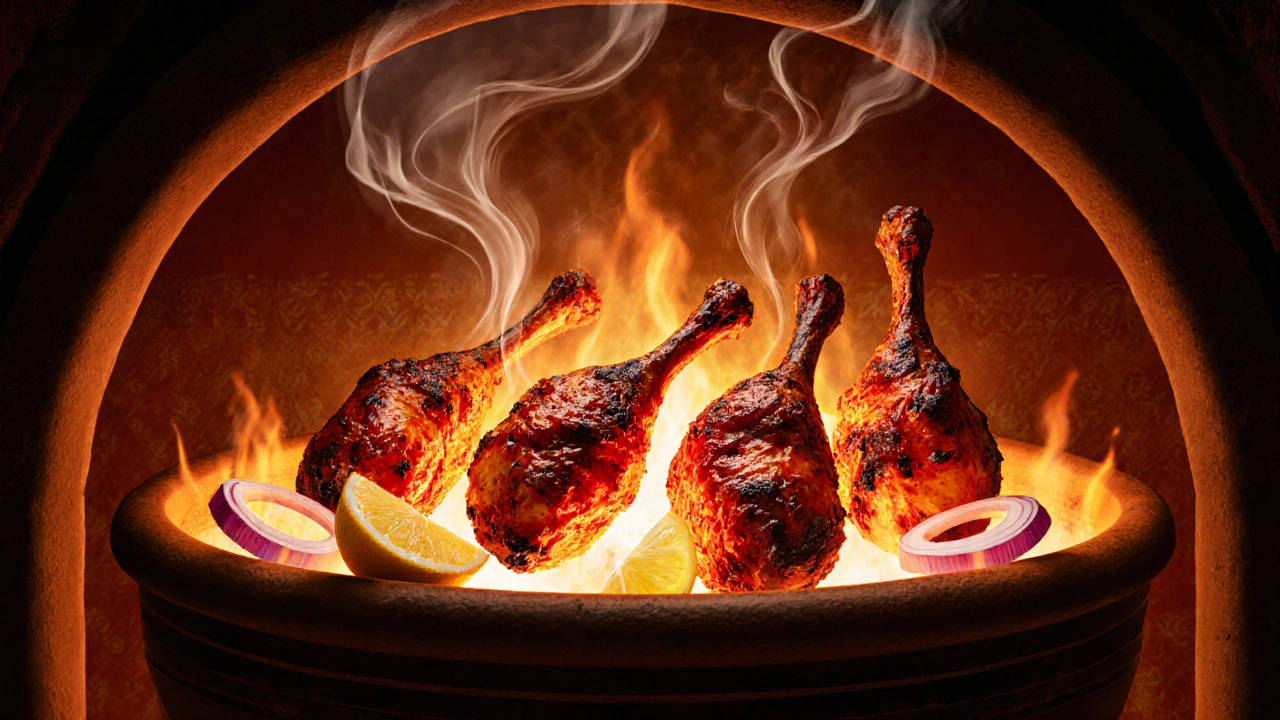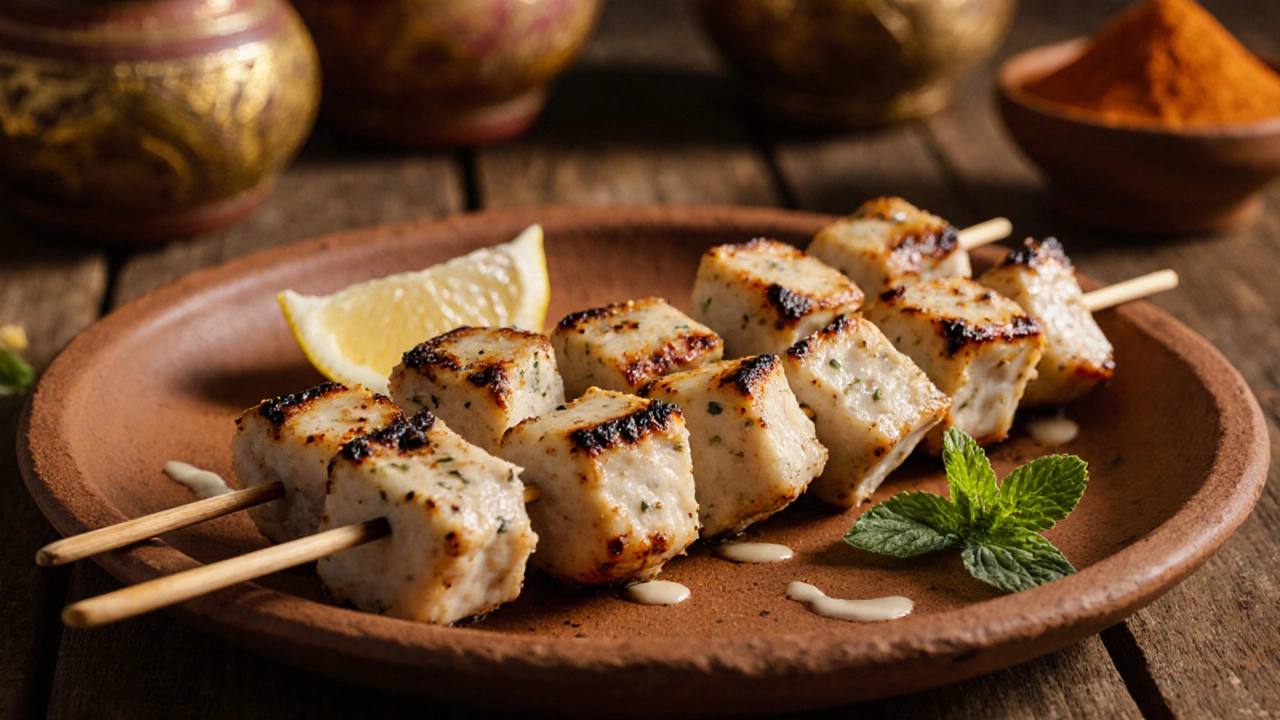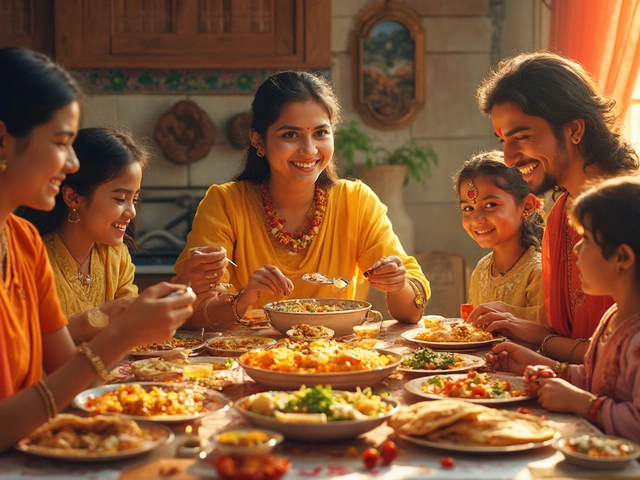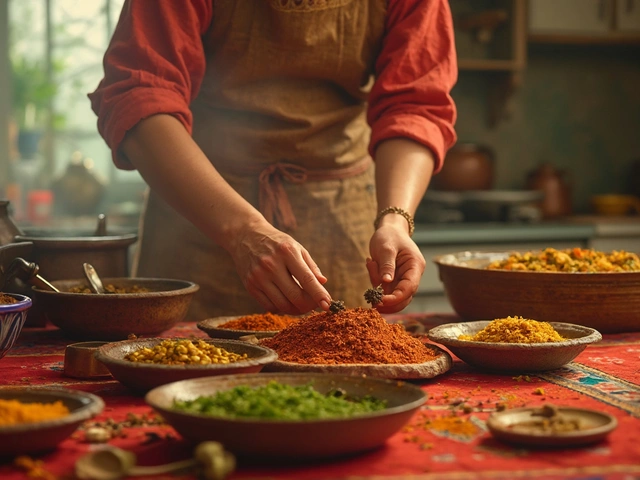Ever ordered chicken tikka and tandoori chicken at a restaurant and wondered why they taste so different-even though both are grilled chicken dishes from India? You’re not alone. Many people think they’re the same thing. But they’re not. The difference isn’t just in the name. It’s in the marinade, the cut of meat, the cooking method, and even how they’re served. If you’ve ever made tandoori chicken at home and ended up with something that looked like chicken tikka, you’re probably missing a key step.
Chicken Tikka: Bite-Sized and Creamy
Chicken tikka starts with boneless chicken pieces-usually breast or thigh-cut into 1-inch cubes. These cubes are soaked in a thick, creamy marinade that’s heavy on yogurt, cream, and sometimes cashew paste. The yogurt doesn’t just tenderize the meat; it helps the spices cling to every surface. You’ll find ground cumin, coriander, garam masala, turmeric, and a good kick of chili powder. Some versions even add a touch of lemon juice or honey for balance.
The magic of chicken tikka happens in the marinade time. Most recipes call for at least 4 hours, but overnight is best. That long soak lets the yogurt break down the proteins just enough so the chicken stays juicy under high heat. When it’s time to cook, the cubes go on skewers and into a hot oven or grill. The result? Tender, slightly charred bites with a rich, creamy flavor that’s milder than you’d expect.
Chicken tikka is often served as an appetizer, sometimes with mint chutney or a side of onion rings. In the UK, it’s the base for chicken tikka masala-the most popular Indian dish in Britain. But back in India, it’s usually just grilled chicken on a stick, eaten as a snack or part of a larger meal.
Tandoori Chicken: Whole, Spicy, and Smoky
Tandoori chicken is the opposite in almost every way. It’s made with whole chicken pieces-thighs, drumsticks, or even a quartered bird. The skin stays on, and the meat is left in larger chunks. The marinade is thinner, less creamy, and way more aggressive with spices. Yogurt is still the base, but it’s mixed with lemon juice, garlic, ginger, and a lot more red chili powder. The real secret? Kashmiri red chili. It gives that signature bright red color without overwhelming heat. Some cooks add a pinch of food-grade red dye for that classic restaurant look.
What sets tandoori chicken apart is the cooking method. Traditionally, it’s cooked in a tandoor-a clay oven that hits temperatures over 480°C (900°F). The high heat sears the outside fast, locking in juices while the spices char slightly and create a smoky crust. If you don’t have a tandoor, you can get close with a grill or broiler, but you’ll need to keep the heat high and the chicken close to the flame.
The flavor? Bold, smoky, and spicy-with a tang from the lemon and yogurt. The skin gets crispy, and the meat underneath stays moist. Tandoori chicken is usually served as a main dish, often with onion slices, lemon wedges, and a side of mint-coriander chutney. In India, it’s a staple at parties and festivals. You’ll see it at weddings, roadside stalls, and family dinners.
Marinade Comparison: Yogurt, Spices, and Texture
The biggest difference between the two dishes? The marinade. Chicken tikka’s marinade is thick, almost like a paste. It’s meant to coat every cube evenly and create a soft, creamy crust. Tandoori chicken’s marinade is thinner, more like a wet rub. It clings to the meat but doesn’t form a thick layer. That’s why tandoori chicken has a crispier skin and more intense spice penetration.
Here’s how they stack up:
| Component | Chicken Tikka | Tandoori Chicken |
|---|---|---|
| Chicken Cut | Boneless cubes | Bone-in pieces |
| Marinade Texture | Thick, creamy paste | Thin, wet rub |
| Key Dairy | Yogurt + cream or cashew paste | Yogurt only |
| Primary Spice | Garam masala, mild chili | Kashmiri chili, cumin, garlic |
| Color | Light orange or beige | Bright red |
| Cooking Time | 10-15 minutes | 20-30 minutes |
Don’t be fooled by the color. That bright red in tandoori chicken? It’s not just from chili. It’s from the way the spices react to the heat and the yogurt. Chicken tikka doesn’t need that color-it’s about texture and creaminess, not visual drama.

Cooking Method Matters
Both dishes are grilled, but the way they’re cooked changes everything. Chicken tikka is cooked quickly over high heat because the pieces are small. You don’t need to wait long for the inside to cook through. Tandoori chicken, with its bones and thicker cuts, needs more time. The goal isn’t just to sear-it’s to roast the meat slowly enough to keep it juicy while the spices develop depth.
If you’re using a home oven, place the chicken on a wire rack over a baking sheet. That lets air circulate and helps the skin crisp up. For tandoori chicken, broil on high for the last 5 minutes to get that charred edge. Chicken tikka? Just grill until the edges start to blacken slightly. Don’t overcook it-the yogurt will make it dry.
Serving Styles and Cultural Roots
Chicken tikka is often a snack. In Punjab, street vendors sell it on sticks with a squeeze of lemon. In London, it’s the star of curry house menus. Tandoori chicken, on the other hand, is a full-meal dish. In India, it’s served with naan, basmati rice, and raita. You’ll find it on wedding buffets, festival tables, and even in airline meals.
The cultural difference is subtle but real. Chicken tikka evolved as a portable, snackable version of grilled chicken. Tandoori chicken was born in the tandoor ovens of North India, where whole birds were roasted for large gatherings. One is about convenience; the other is about tradition.

Can You Substitute One for the Other?
Technically, yes. If you marinate boneless chicken in tandoori spices and grill it, you’ll get something close to chicken tikka. But it won’t be the same. The creamy texture of tikka marinade gives it a richness that tandoori chicken doesn’t have. And if you try to cook tandoori chicken with boneless cubes, you’ll end up with dry, overcooked meat.
For the best results, stick to the traditional cuts and marinades. If you want tender, creamy bites, go for chicken tikka. If you want smoky, spicy, juicy chunks with a kick, make tandoori chicken. They’re both amazing-but they’re not interchangeable.
Common Mistakes to Avoid
- Using boneless chicken for tandoori chicken-this leads to dry, rubbery meat.
- Skipping the yogurt marinade time-both dishes need at least 4 hours, preferably overnight.
- Using sweet paprika instead of Kashmiri chili-this kills the authentic color and flavor.
- Grilling chicken tikka too long-it’s meant to be tender, not charred to a crisp.
- Adding too much cream to tandoori marinade-it should be spicy, not creamy.
One last tip: If you’re making tandoori chicken and the color isn’t red enough, add a pinch of food-grade red dye. It’s not cheating-it’s tradition. Many restaurants in India use it. Homemade versions can look pale without it.
Is chicken tikka the same as tandoori chicken?
No. Chicken tikka uses boneless cubes in a creamy yogurt marinade and is cooked quickly. Tandoori chicken uses bone-in pieces in a thinner, spicier marinade and is slow-roasted for a smoky flavor. They’re different dishes with different textures, flavors, and traditions.
Why is tandoori chicken red?
The red color comes from Kashmiri chili powder, which gives vibrant color without extreme heat. Some recipes also use a tiny bit of food-grade red dye, especially in restaurants, to ensure the bright hue. Homemade versions may look paler without it, but the flavor is still authentic.
Can I make chicken tikka without cream?
Yes. While cream or cashew paste adds richness, you can skip it and still get tender chicken. Just use full-fat yogurt and marinate longer-overnight if possible. The yogurt alone will tenderize the meat and keep it moist.
Which one is spicier-chicken tikka or tandoori chicken?
Tandoori chicken is usually spicier. It uses more chili powder and less dairy to balance the heat. Chicken tikka is milder because the cream and yogurt mute the spices, making it more approachable for casual eaters.
Can I use a regular oven for tandoori chicken?
Yes, but you need to mimic the tandoor. Preheat your oven to its highest setting (around 260°C/500°F). Place the chicken on a wire rack over a baking sheet and broil for the last 5-10 minutes to char the surface. A grill works even better if you have one.
What to Try Next
If you’ve mastered chicken tikka and tandoori chicken, try making chicken tikka masala next. It’s the same grilled chicken, but simmered in a creamy tomato sauce with spices. Or make a tandoori chicken salad with cucumber, red onion, and a yogurt dressing. Both are easy, delicious, and show how versatile these two dishes really are.











